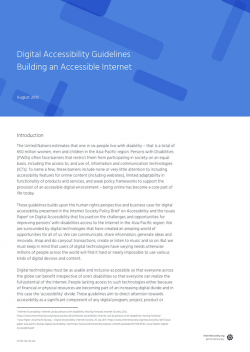Introduction
The United Nations estimates that one in six people live with disability – that is a total of 650 million women, men and children in the Asia-Pacific region. Persons with Disabilities (PWDs) often face barriers that restrict them from participating in society on an equal basis, including the access to, and use of, information and communication technologies (ICTs). To name a few, these barriers include none or very little attention to including accessibility features for online content (including websites), limited adaptability in functionality of products and services, and weak policy frameworks to support the provision of an accessible digital environment – being online has become a core part of life today.
These guidelines builds upon the human rights perspective and business case for digital accessibility presented in the Internet Society Policy Brief[1] on Accessibility and the Issues Paper[2] on Digital Accessibility that focused on the challenges and opportunities for improving persons’ with disabilities access to the Internet in the Asia-Pacific region. We are surrounded by digital technologies that have created an amazing world of opportunities for all of us. We can communicate, share information, generate ideas and innovate, shop and do carryout transactions, create or listen to music and so on. But we must keep in mind that users of digital technologies have varying needs otherwise millions of people across the world will find it hard or nearly impossible to use various kinds of digital devices and content.
Digital technologies must be as usable and inclusive as possible so that everyone across the globe can benefit irrespective of one’s disabilities so that everyone can realize the full potential of the Internet. People lacking access to such technologies either because of financial or physical resources are becoming part of an increasing digital divide and in this case the ‘accessibility’ divide. These guidelines aim to direct attention towards accessibility as a significant component of any digital program, project, product or service. Anything that is placed online can be accessed globally therefore it should be accessible by everyone with or without disabilities.
[1] Internet Accessibility: Internet use by persons with disabilities: Moving Forward. Internet Society. 2012. https://www.internetsociety.org/resources/doc/2012/internet-accessibility-internet-use-by-persons-with-disabilities-moving-forward/
[2] Issue Paper: Asia-Pacific Bureau – Digital Accessibility. Internet Society. 25 July 2017. https://www.internetsociety.org/resources/doc/2017/issue-paper-asia-pacific-bureau-digital-accessibility/ and https://www.internetsociety.org/wp-content/uploads/2017/09/APAC-Issue-Papers-Digital-Accessibility.pdf
